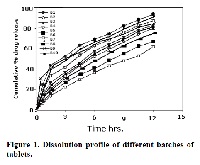An Emerging Trend in Tablet Technology:- Floating Tablets of Ranitidine HCl
Keywords:
Ranitidine, Floating tablets, MethocelAbstract
The rationale of this research was to prepare a gastroretentive drug delivery system of Ranitidine HCL. Floating Drug delivery system used to target drug release in the stomach or to the upper part of the intestine. The oral delivery of Ranitidine is tested by preparing a non-disintegrating floating dosage form, which increase its absorption in the stomach by increasing the drug’s gastric residence time. The polymer PVC and Sodium bicarbonate was used as the gas–generating agents. Sodium bicarbonate causes the tablets to floats for more then 24hr. The prepared tablets were evaluated on their physicochemical properties and drug release characters. In-vitro release studies indicate that the Ranitidine release form the floating dosage form was uniform followed zero order release. A combination of sodium bicarbonate (70mg) and citric acid (15mg) was found to achieve Optimum in vitro buoyancy. The tablets with methocel K100 were found to float for longer duration of time as compared to formulations containing methocel K15M. The drug release from the tablets was sufficiently sustained.
References
B Reynolds, J.E.F. Martindale The Extra
Pharmacopoeia, The Royal Pharmaceutical Society:
London, 1996, pp.1218
Santus G, Lazzarini G, Bottoni G, et al. An in
vitro-in vivo investigation of oral bioadhesive
controlled release furosemide formulations. Eur J
Pharm Biopharm. 1997; 44:39-52.
Deshpande AA, Rhodes CT, Shah NH, Malick AW
. Controlled-release drug delivery systems for
prolonged gastric residence: an overview. Drug
Dev Ind Pharm. 1996; 22:531-539.
Deshpande AA, Shah NH, Rhodes CT, Malick W.
Development of a novel controlled-release system
for gastric retention. Pharm Res. 1997; 14:815-819.
Reynolds, J.E.F. Martindale the Extra
Pharmacopoeia, The Royal Pharmaceutical Society:
London, 1996, pp.1219.
Basit A, Lacey L. Colonic metabolism of
ranitidine: implications for its delivery and
absorption. Int J Pharm. 2001; 227:157-165.
Singh, B; Kim, K. J. Control. Release, 2000, 63,
-59.
Coffin, M; Parr, A. US Patent 5 407 687, April 18,
Rosa, M.; Zia, H.; Rhodes, T. Int. J. Pharm., 1994,
, 65-70.
Jadon,R.S., Vaidya V.D., Khemariya P. and Nayak
S. Taste Masking of Lornoxicam by Polymer
Carrier System and Formulation of Oral
Disintegrating Tablets. IJDD 2009; 1: 1-3.





